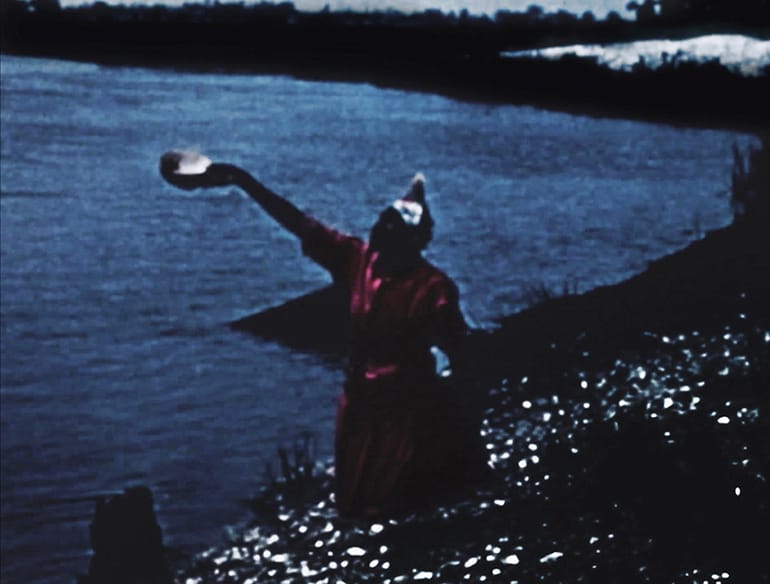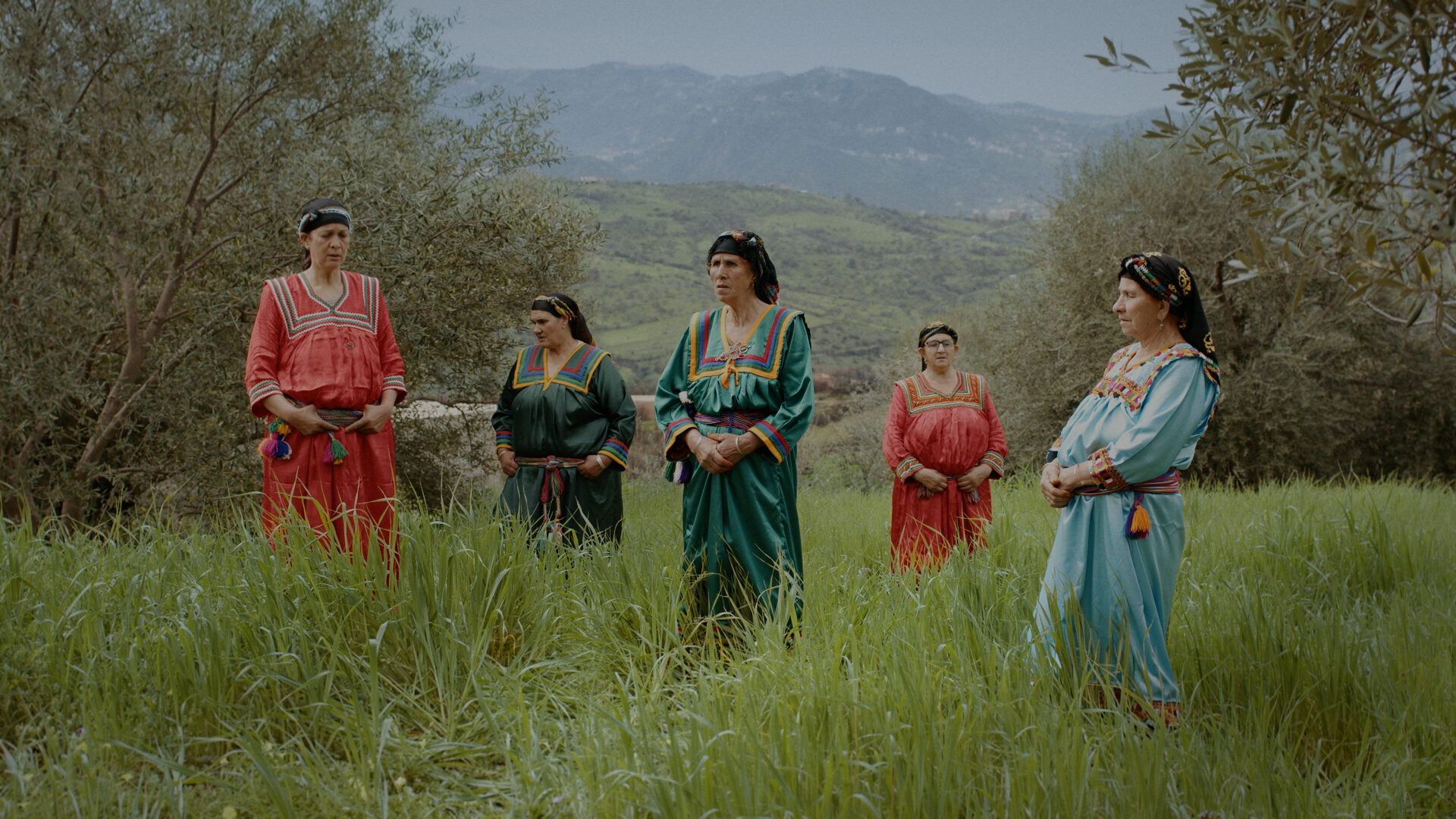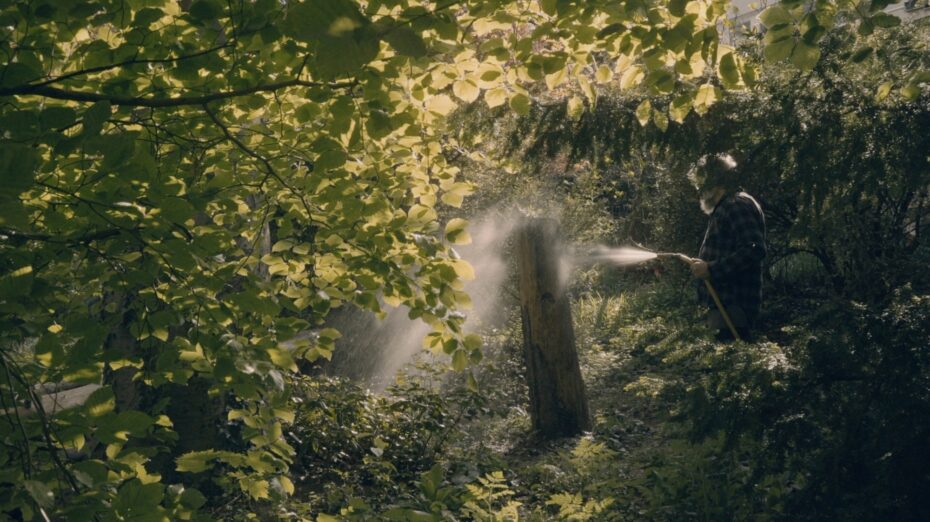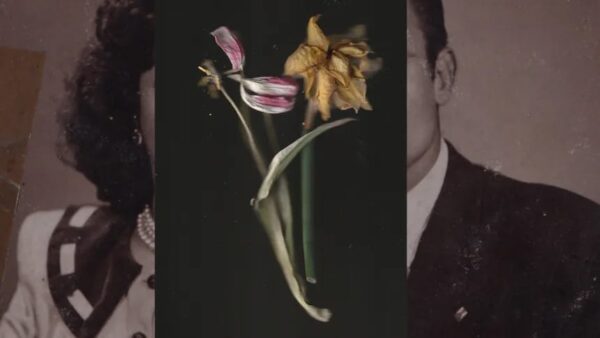Cosmos And Chaos And Cosmos And…
The Gravity Of Rituals
Amongst the many great films in IDFA’s short film competition this year, hailing from the mountains of Buthan all the way to the jungle of Colombia, an overwhelming majority flirts with the idea of rituals.

‘‘Chaos,” a woman says, gravely concerned. ‘‘There’s no more olive trees, […] nothing. The earth is as burned as I am.” As the camera looks down on the beautiful landscape of Kabylia, a mountainous region in Northern Algeria, home to the Kabyle people, rows of blackened dead trees sprinkle the land as far as the eyes can see. Here, forest fires have unsurprisingly grown in intensity in the past few years. Their forceful presence, renewed every summer, is making the lives of locals like Ouiza and Taos Chabi increasingly difficult.
The women’s livelihood, mainly supported by gruelling, back-breaking agricultural work, is endangered, and so is their whole community, the source of their sense of security and belonging. As the woman goes through the inventory of her misfortunes, the audience soon realises how dire her situation is; one where it may even be understandable to envy the blessed dead, comfortably resting underground in the village cemetery, unbothered by the scent of burned ash floating in the air. Yet, despite it all, she and her friends still find time to gather and drink tea, laugh, and sing.
Achewiq is a traditional type of music, native to Kabylia, typically exclusively performed by women. Unsupported by any instruments, the music is only composed of singing voices layered on top of each other in order to achieve a harmonious result. Analogous to a form of prayer, the Achewiq is specifically meant to allow the singers to commune and express a feeling of deep joy or, in the case of Elina Kastler’s film, intense grief.
Achewiq, the Song of the Brave Women, one of the many documentaries created by students at the French school Le Fresnoy this year, is one of the nineteen short films that screened in competition at the 35th edition of the International Documentary Film Festival in Amsterdam (IDFA). Amongst those films, hailing from the mountains of Buthan all the way to the jungle of Colombia, an overwhelming majority flirts with the idea of rituals. Rituals are a social custom, a system of rites (religious and non-religious), a communion between like-minded people, or, most simply put, a series of acts designed to give power back to its participants. Rituals are designed to give purpose, appeasement, or perhaps even a sense of healing.

Achewiq, the Song of the Brave Women (Elina Kastler, 2022)
Scholars say that rituals are mostly defined by their structure. Their purpose is anchored in the participant’s mind by the fact that they are repeatable, familiar, and predictable. Their fundamental existence has mostly always been to fight the uncertainties of our world and to try and tame what is out of our hands. Furthermore, when trying to identify a common thread in the way past and present civilizations deal with existential questions through the use of rites and rituals, famous historian Mircea Eliade once coined the word ‘’cosmos’’ in relation to the word ‘’chaos’’; the former being a symbol of order and stability, the antonym of the latter1. He explained that a substantial amount of humanity’s founding rituals (notwithstanding their meaning or their place of origin) are built in a cyclical manner, meant to allow the participant to travel from one state to the other and back. From cosmos to chaos and, ideally, back to cosmos, having been transformed by the lessons learned on this journey. Filmmakers and writers alike will have a sense of déjà vu here: storytelling 101 is based on the very same principle.
Hence, when Kastler sits in a small house in Kabylia’s countryside, filming a group of women sighing after performing a painful Achewiq, feeling relieved despite the poor state of their marriage or the ill fate of their land, I can’t help but draw parallels between them and the Swiss characters of Mountain Flesh, land surveyors and worshippers alike, as well as with the black youth of Brussels in The Porters. All of these characters are framed within the context of a ritual.
In the first case, boasting a striking black-and-white cinematography, the camera follows silhouettes of land surveyors while they methodically report on the latest landslides that have been afflicting Switzerland, another byproduct of climate change. As they go about their day, priests and religious devotees, another set of characters, enter the frame as they pray, sing, and beg the Lord to ‘‘save [their] place from disaster, catastrophe and these slippery rocks.’’ Science and faith, two eternally-conflicted lenses used to see and understand the world, are showcased side by side in Mountain Flesh by Valentina Shasivari as they manage to cohabit in a surprisingly coherent fashion.
Here, the filmmaker’s intentions are refreshingly straightforward and openly displayed to the audience despite its minimal use of editing, sound design, and blocking. By simply filming workers and worshippers, both at a fair distance from the camera and under the majestic and towering facades of nearby mountains, there’s a power structure that is automatically established between man and Nature, which one could define as horribly unbalanced. As the sound of crumbling rocks grows fiercely in the distance, it becomes clear that on both sides of the aisle, science and faith alike, and in the current state of our planet, humans have been submerged in the fight, incapable of joining forces as the scope of their problems has become too big to even grasp. In their own little ways, all the silhouettes displayed in this film are witnessed trying to figure out their place in what is bound to be a changing landscape. The rocks will keep on rolling down the hills, and they will keep on weakening the villages’ infrastructures sitting at the bottom, no matter what they do. Nature is simply too powerful.
It could be argued that land surveyors tirelessly collecting data and choir singers giving a show under the local church’s cracked roof are nothing more than different manifestations of the same desire. Both want to feel empowered and to keep some form of control over their lives during this period of climate transition. They both are participants in different rituals of faith and science, which by their repeated and familiar nature, as stated, give them a sense of structure despite the unpredictability of what lies in their community’s near future.
In The Porters, Belgian filmmaker Sarah Vanagt plays on a completely different level. Instead of presenting herself as a mere witness of already established rituals, she and her crew bring said ritual directly to volunteering participants who, evidently, have never engaged in a similar practice before. The idea is simple, novel, and fun. Vanagt takes a popular memory game consisting of repeating and adding words to an ever-growing list of items that participants would bring on a trip, but there’s a twist. Each of these words has to come from ‘‘a packing list of 8,000 objects from a colonial expedition to the former Belgian Congo. The list includes a spear, ten beetles, an ivory horn, an elephant-hair chain, and 140 meters of film of pygmies fighting, etc.’’
What seems like a quirky game at first rapidly evolves into something much more profound. The participants are mostly young black friends, reunited in parks across the city of Brussels. They’re casual, easygoing, and at ease in an environment they feel comfortable in: it would be too easy to suggest that the harsh memories of slavery and colonialism are definitely gone, leaving these young men and women unscathed, free of any mental scars. But by forcing a connection between the modern youth of Belgium with the archaic nature of these words which seem to belong to a bygone era, Vanagt proves that the past may indeed be the past, but it is much closer than we may be comfortable to admit: a conclusion the participants arrive to themselves while playing the game in front of the camera.
Ultimately, as the film comes to an end and the audience is left wondering what the real purpose of the game is, I would claim that it is simply to acknowledge a basic yet necessary step on the road to a more comprehensive societal healing. As the young men and women go through the list of colonial objects and watch archival footage of the Belgian Congo, they start to establish a relationship with these objects and their distant indigenous users, relating to their plight and integrating their memories into their own. In turn, this small process eventually allows them to more acutely see equivalent injustices in their own lives, an empowering tool when it comes to having a collective conversation about the colonial legacy we are still juggling with today.

The Silence of the Banana Trees (Eneos Carka, 2022)
In the same vein, but arguably with an even sharper desire to be an active agent of change, The Silence of the Banana Trees and Solmatuala are two great examples of films in IDFA’s short film competition that embody the concept of ritual in the filmmaking process itself. The making of these films is a ritual, as it’s what gives purpose and power to its participants.
In the former, a Hungarian man grieves, living alone in a cosy house filled to the brim with artworks done by his daughter Réka. Mihály is devastated because he doesn’t speak with Réka anymore, as per her wishes. Sick, possibly from life-altering cancer, she is living abroad, and the reasons behind her separation from her father are sealed from the audience as filmmaker Eneos Carka quickly establishes that he isn’t interested in such details. Instead, as he spends time with Mihály, a man he has great chemistry with—much to the delight of the audience—Carka encourages his friend to invite us on a journey down memory lane.
This inner quest of his, supported by a myriad of photographs and videos captured by Mihály at a time when his family was still intact, acts like a painful catalyst for our protagonist. However, I feel like it is important to mention that the reminiscence of these distant life fragments isn’t meant to punish him, as he’s possibly already flooded by feelings of regret and guilt. Quite the contrary. In fact, the tenderness with which Carka films his friend allows the audience to ground itself in the present in such a way that it is impossible for them to see anything else than the man Mihály is today. Never mind the possible faults he made in the past, leading him to lose touch with Réka. He is what he is now, and the making of the film, behaving like a ritualistic mirror of some sort, seems to allow Mihály to understand that and perhaps even forgive Réka and eventually forgive himself.
Finally, in Solmatalua, a visual poem of visceral beauty, Brazilian experimental artist Rodrigo Ribeiro-Andrade embarks the audience on a cyclical dreamy voyage, a ritual of his own making, within the maze-like streets of Brazil’s favelas, drawing his inspirations from the collective traumas of his ancestors, all in the hopes of establishing a new recontextualized and impressionistic vision of African diasporas’ history. The filmmaker, not shying away from using very different media sources as his foundation, courageously opens his film with a male voice claiming: ‘‘I was a king, and now I’m a slave’’. It is interesting to note how this statement, in itself, should suggest some sort of closure, since being a slave has historically been seen as humanity’s cul-de-sac: a slave is already a half-dead man, he doesn’t have a future.
Though Ribeiro-Andrade makes sure they are the first words the audience hears, he makes it clear that he does not consider such a devastating fate to be the end. In fact, he goes even further only a few seconds later by letting his narrator reverse the statement back on its head: ‘‘I was a slave, and I shall be king’’. Slavery, as destructive and earth-shattering as it was and still is, never was the end, insists Ribeiro-Andrade. It was just a beginning, one among many others, in a long stretch of cosmos and chaos and cosmos and chaos from which the African diasporas will always rise, no matter what, again and again and again and again and…

